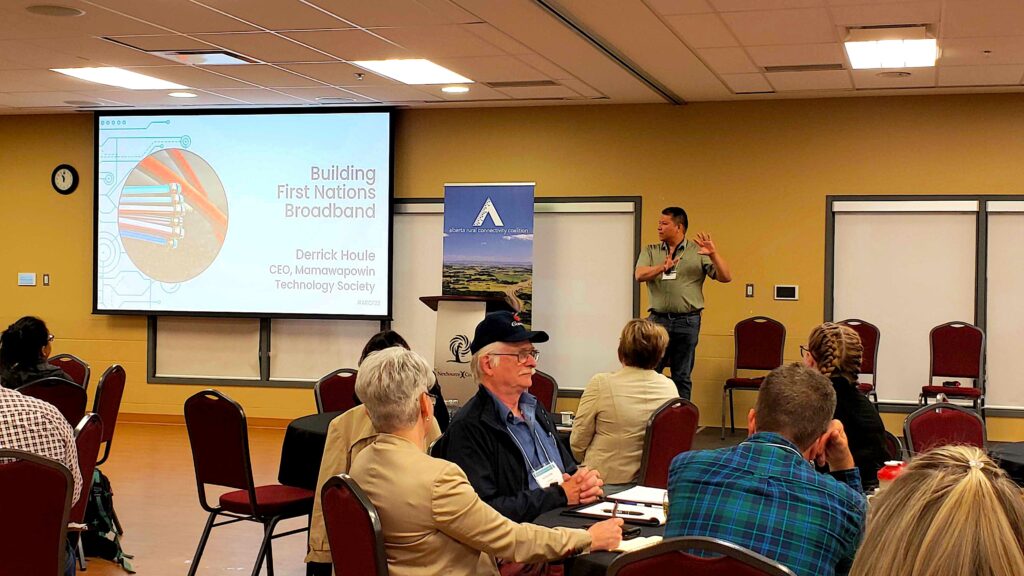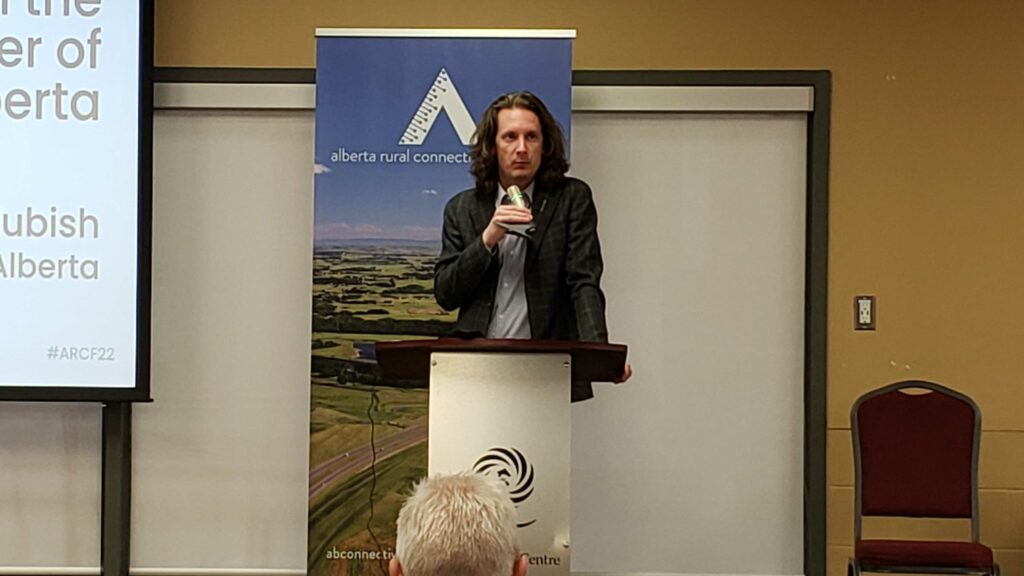Last month, the Alberta Rural Connectivity Coalition (ARCC) hosted its second annual Alberta Rural Connectivity Forum, which brought together community leaders from across the province. The two-day event, held in Sylvan Lake, highlighted the differing internet access issues faced by many Alberta communities, and evaluated opportunities available through the Government of Alberta’s new rural broadband strategy.
The event opened with University of Alberta researcher and ARCC steering committee member Dr. Michael McNally reviewing the key issues facing Alberta connectivity. He emphasized that, although improving connectivity can create a technological and capital problem for communities, the positive social impacts these investments can have on the community are quite large.
Dr. McNally also contrasted the different solutions to Alberta’s rural connectivity issues, including wireless, fixed wireless, and terrestrial solutions such as Low Earth Orbit (LEO) satellites. He noted there is no one solution for the entire province, and the best technology to use depends on different criteria like population density and geographic terrain. Reaching optimal connectivity in Alberta will likely require a mix of solutions.
His opening discussion was followed by testimonials on community solutions by different rural municipalities. City of Brooks CAO, Alan Martens, explained the steps the city took to develop a “co-ownership” with Crown Capital to solidify over $20 million in funding for a fibre build. The municipality originally considered utilizing a dark fibre line — that is, existing fibre that has not been put into service — to solve its connectivity issues, but abandoned this solution upon realizing accessing that line would be cost prohibitive.
While Brooks managed to develop a fibre network through the leadership of its council, shifts in government brought about by elections can often impede these developments. Greg Potter, President of Foothills Fiber Cooperative, outlined how a group of community leaders in Foothills County — located west of Calgary — is launching a fibre cooperative to sidestep infrastructure delays caused by governmental changes. These fibre coops are expected to serve Alberta’s communities much like credit unions or utility coops did in the early 1900’s. They particularly support communities with low population densities, where private enterprise simply could not find the business case to operate. Once off the ground, Foothills Fibre Cooperative will be member-owned and operated, with revenue being reinvested into the coop itself.
Similar to Brooks, a representative from Sturgeon County highlighted how their community-based solution — which involves the county owning its own assets — will enable them to ensure market competition, while also protecting the taxpayer. Like Foothills County, Sturgeon shares a boundary with a major city — Edmonton. Despite this proximity to an urban centre, the County, and most of its residents, do not have access to high speed internet.
The community has struggled for years to access the nationally provisioned Universal Broadband Fund (UBF) because, despite most residents not having high speed internet, national broadband service maps show they have access to “adequate speed.” These official maps, which can be the determining factor if a community gets internet funding, often lack a detailed scope (lumping connected and non-connected regions together). The County’s access to funding is even more limited now that the Universal Broadband Fund is facilitating both the federal and provincial disbursement of funds.
Sturgeon County has been able to prove their connectivity challenges by leveraging the speed test data from the Canadian Internet Registration Authority (CIRA), the organization that manages the .ca domain. Grant Street, a product manager from CIRA, spoke at the conference about how any community can take advantage of these speed tests to demonstrate a need, and also hold internet carriers accountable to the internet speeds they committed to provide.

Derrick Houle, the CEO for Mamawapowin Technology Society, provided a compelling dialogue about First Nations connectivity and its role in the broader conversation of reconciliation. Mamawapowin is a not-for-profit that supports the development of internet assets in the community of Maskwacis. Houle described how colonialism and previous governments’ interference in First Nations communities’ economies and self determination has created tremendous barriers for these groups. He also provided some examples of Alberta rural communities working with First Nations communities to ensure sustainability for everyone.
Both days of the Forum featured government representative speeches from both the federal and provincial level. Nirmala Niadoo, Alberta and NWT Commissioner for the CRTC, discussed what the CRTC is doing to assist communities with internet builds, including funding $202 million for service builds in 170 communities. She also noted the CRTC is currently directing much of its attention to First Nations communities, as they make up a disproportionate number of the unconnected people in Canada.
Service Alberta Minister Nate Glubish discussed the $780 million investment in broadband the provincial and federal government are making in the province. Since taking on the Ministry role three years ago, Minister Glubish has spoken with many communities about this issue. “Rural connectivity is critical to our economy, it is critical for the education of our kids, it is critical to skill and talent development for almost any industry, and it is critical for health care,” he told Forum attendees.

While taking questions, Minister Glubish also addressed concerns around the UBF being the mechanism to disperse the fund, and its criteria. The Minister suggested solutions his office will take to counter the current funding requirements. This includes ensuring regional fairness and First Nations participation as they advocate for which communities should receive UBF dollars. You can watch Minister Glubish’s full address here.
The Alberta Rural Connectivity Coalition is now working to develop policies and follow-up support to enable more successful broadband builds in Alberta communities. To learn more, or get your community involved, visit abconnectivity.ca.

